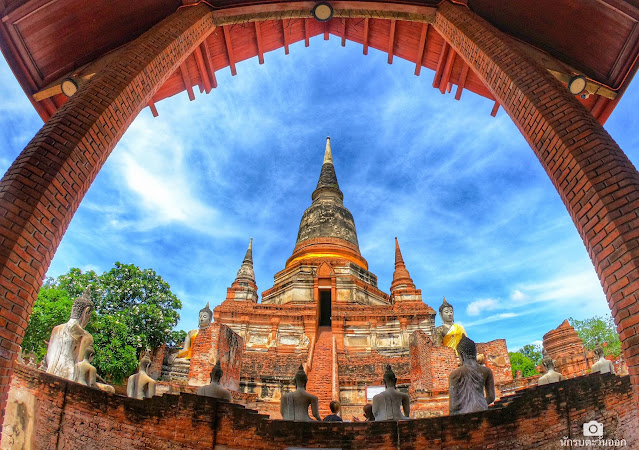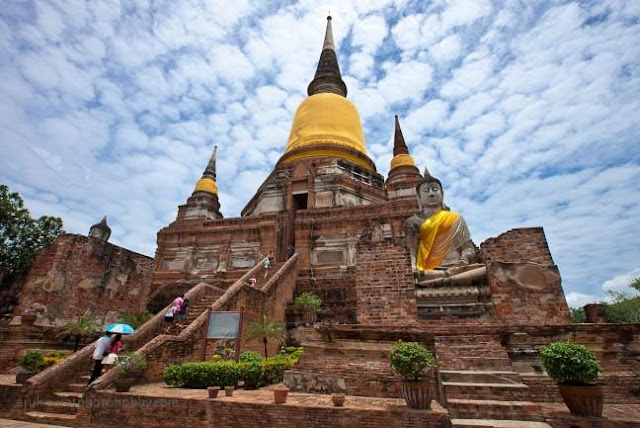WatYaiChaiMongkol (Mongkhon), Ayutthaya, Thailand. / วัดใหญ่ชัยมงคล จ.พระนครศรีอยุธยา
Wat Yai Chai Mongkhon is a Buddhist temple in Ayutthaya, Thailand.
Wat Yai Chai Mongkol (or Mongkhon) is located a few kilometers southeast of Ayutthaya (island). You'll have to cross the Pridithamrong bridge out of the city. It obviously is one of the major temples in the Ayutthaya area, and both tourists and local worshippers visit the wat. Logistically, visiting this temple can be well combined with a visit to Wat Phanan Choeng (open till 5 P.M.).
If you do combine the two, it probably is slightly better to visit Wat Phanan Choeng first, since the attraction there is in-doors. Wat Yai Chai Mongkol stays open till 6 P.M. and you can take better pictures if you come a bit later in the afternoon.
Historical Notes
Wat Phra Chao Phya-thai. populary known as Wat Yai Chaimongkol, is situated to the southeast of the city. The large chedi there can be seen from a great distance.
It was built by King U-thong in 1357 A.D. for the use of the monks who had returned from Ceylon after studying under Phra Vanarat Maha Thera. This body of monks was known as the Pa Kaeo Sect. So this monasteny was originally known as Wat Pa Kaeo. The monks of this sect were engaged mainly in meditation.
Many people who respected the monks joined the order. The king conferred the title of Somdej Phra Vanarat on the head of the sect and appointed him to the position of Patriarch on the Right Hand Side.
Since it was the place where the patriarch stayed, the monastery was named Wat Chao Phya-thai which means The Temple of the Supreme Patriarch.
Reclining Buddha Image at Wat Yai Chai Mongkol
Various royals and princes sought advice here during the Ayutthaya period.
In 1592 A.D. during the reign of King Naresuan the Great, the Burmese led an army to try to subjugate Ayutthaya. King Naresuan resisted the invasion and fought on elephant back with the Burmese leader at the district of Nong Sarai in the province of Suphanburi, and was victorious.
On that occasion, King Naresuan's army was not able to inflict greater losses on the Burmese because many of his regiments did not come to reinforce him in time.
The King wished to execute the officers of those regiments at the conclusion of the war, but Patriarch Vanarat begged the King to pardon them and advised him to build chedis in memory of his great victory.
So King Naresuan built one on the scene of the singlehanded combat at Nong Sarai in Suphanburi, and a bigger one on the premises of Wat Chao Phyathai. This second chedi built by King Naresuan was named Phra Chedi Chai Mongkol, or Chedi of the Auspicious Victory, and it was popularly known as Phra Chedi Yai, or the Great Pagoda.
So. later on Chao PhyaThai came to be known also as Wat Yai Chai Mongkol. The top of this chedi is visible to visitors from Bangkok as soon as they enter the boundary of Ayutthaya.
(historical notes from documents by the Department of Fine Arts)
Source: http://www.ayutthaya2020.com/watyaichaimongkol.asp
วัดใหญ่ชัยมงคล
วัดใหญ่ชัยมงคล ถือว่าเป็นวัดมีความสำคัญทางประวัติศาตร์มากที่สุดและเป็นวัดที่นักท่องเที่ยวนิยมมามากที่สุดวัดหนึ่งในจังหวัดพระนครศรีอยุธยา จึงเป็นธรรมดาที่จะพบเห็นนักท่องเที่ยวจำนวนมากเดินทางมายังวัดแห่งนี้ จุดสนใจของวัดใหญ่ชัยมงคลนี้ คือเรื่องราวทางประวัติศาตร์ในสมัยกรุงศรีอยุธยา รวมไปถึงสถาปัตยกรรมที่โดดเด่น ชมเจดีย์ที่สูงที่สุดในอยุธยา ด้านหลังวัดมีตำหนักสมเด็จพระนเรศวรมหาราช ให้ผู้นับถือศรัทธาเข้ามากราบไหว้ นอกจากนี้ บริเวณ รอบๆ ยังมีมีสวนหย่อมที่สวยงามให้พักผ่อนอีกด้วยนักท่องเที่ยวที่ต้องการมาเที่ยวอยุธยาจึงไม่ควรพลาดอย่างยิ่ง
ประวัติ วัดใหญ่ชัยมงคล เป็นวัดที่เก่าแก่วัดหนึ่ง สร้างขึ้นในสมัยอยุธยาตอนต้น คือ ในรัชสมัยของสมเด็จพระรามาธิปดีที่ 1 หรืออีกพระนามหนึ่งคือ สมเด็จพระเจ้าอู่ทองพระมหากษัตริย์ผู้สถาปนากรุงศรีอยุธยา ตามตำนานกล่าวว่า เมื่อ พ.ศ.1900 สมเด็จพระเจ้าอู่ทองได้ทรงพระกรุณาโปรดเกล้าฯให้ขุดศพเจ้าแก้ว ซึ่งทิวงคตด้วยอหิวาตกโรคขึ้นมาเผา ที่ปลงศพนั้นโปรดให้สถาปนาเป็นพระอาราม นามว่า วัดป่าแก้ว
ต่อมาคณะสงฆ์สำนักวัดป่าแก้ว บวชเรียนมา จากสำนักรัตนมหาเถระ ในประเทศศรีลังกาคณะสงฆ์นี้ได้เป็นที่เคารพเลื่อมใสแก่ชาวกรุงศรีอยุธยาเป็นอันมาก ทำให้ผู้คนต่างมาบวชเรียนในสำนักสงฆ์คณะป่าแก้วมากขึ้น สมเด็จพระเจ้าอู่ทอง จึงทรงตั้งอธิบดีสงฆ์นิกายนี้เป็นสมเด็จพระวันรัตน มีตำแหน่งเป็นพระสังฆราชฝ่ายขวาคู่กับสมเด็จพระพุทธโฆษาจารย์ซึ่งมีตำแหน่งเป็นสังฆราชฝ่ายคันถธุระ
เรื่องราวสำคัญในประวัติศาสตร์ของวัดป่าแก้ว มีอยู่ว่า อุโบสถของวัดเคยเป็นที่ซึ่งคณะคิดกำจัดขุนวรวงศาธิราชกับท้าวศรีสุดาจันทร์มาประชุมเสี่ยงเทียนอธิษฐาน ครั้งนั้นได้รับผลสำเร็จจึงอัญเชิญพระเฑียรราชาลาผนวช ขึ้นครองราชสมบัติทรงพระนามว่า สมเด็จพระมหาจักรพรรดิพ.ศ. ๒๑๐๔ ในรัชกาลของสมเด็จพระมหาจักรพรรดินั้นเอง ได้มีพระบรมราชโองการให้เอาสังฆราชวัดป่าแก้วไปสำเร็จโทษ ฐานฝักใฝ่ให้ฤกษ์ยามแก่ฝ่ายกบฎพระศรีศิลป์ พ.ศ. ๒๑๓๕ ในแผ่นดินของพระนเรศวรมหาราช มีเหตุการณ์สำคัญที่ชวนให้เข้าใจว่ามีการสร้างปฎิสังขรณ์เจดีย์ประธานวัด เพื่อเฉลิมพระเกียรติยศของพระองค์ที่ได้ชัยชนะพระมหาอุปราชแห่งพม่า จึงทำให้เชื่อว่าเป็นที่มาของชื่อวัดใหญ่ชัยมงคล
จุดที่น่าสนใจ เจดีย์ชัยมงคลอนุสรณ์แห่งชัยชนะอันยิ่งใหญ ่ที่สมเด็จพระนเรศวรมหาราชทรงรบชนะ มังกะยอชวาพระมหาอุปราชของหงษาวดี ที่ต.หนองสาหร่าย จ.สุพรรณบุรีในครั้งนั้นพม่าได้ยกทัพเข้ามาในขอบขันฑสีมา สมเด็จพระนเรศวรฯ และสมเด็จพระเอกาทศรถผู้เป็นพระอนุชาจึงได้นำทัพไปรับศึก และได้ขับช้างเข้าไปอยู่ในวงล้อมของข้าศึกทีคอยระดมยิงปืนเข้าใส่พระและพระคชาธาร โดยที่เหล่าแม่ทัพนายกองวิ่งตามพะรองค์มาไม่ทันพระองค์จึงประกาศด้วยพระสุรเสียงอันดังว่า พระเจ้าพี่เราจะยืนอยู่ไยในร่มไม้เล่าเชิญออกมาทำยุทธหัตถีด้วยกัน ให้เป็นเกียรติยศไว้ในแผ่นดินเถิด ภายหน้าไปไม่มีกษัตริย์ที่จะได้ยุทธหัตถีแล้ว พระอุปราชของพม่าจึงไสยช้างออกมากระยุทธถีด้วยกันในการทำยุทธหัตถีครั้งนั้นสมเด็จพระนเรศวรได้ทรงใช้พระแสงพลผ่ายฟาดฟันพระอุปราชขาดตะพายแล่ง
เมื่อกลับมาสู่พระนครแล้ว พระองค์ก็จะลงโทษเหล่าทหารที่ตามพระไปไม่ทันตอนกระทำศึกยุทธหัตถี ซึ่งมากฏระะเบียบแล้วต้องโทษถึงขึ้นประหารชีวิต ช่วงเวลาที่รออาญาสมเด็จพระพันรัตน พระสังฆราชพร้อมด้วยพระสงฆ์ 25 รูปได้ขอให้พระนเรศวรพระราชทานอภัยยกเว้นโทษให้กับทหารเหล่านั้น โดยให้เหตุผลว่าพระองค์เปรียบดังพระสัมมาสัมพุทธเจ้าที่แวดล้อมด้วยหมู่มารก่อนที่จะตรัสรู้ เป็นการประกาศเกียรติและบารมีความกล้าหาญและเก่งกาจของพระองค์ให้ขจรกระจายไปทั่วแคว้นทั่วแผ่นดินสมเด็จพระนเรศวรจึงโปรดให้สร้างเจดีย์องค์ใหญ่ขึ้น เพื่อเป็นสัญลักษณ์แห่งชัยชนะและความมีน้ำพระทัยของพระองค์ ที่มีต่อเหล่าทหารเหล่านั้น และพระะราชทานนามว่า “เจดีย์ชัยมงคล”
ที่มา : https://ww2.ayutthaya.go.th/travel/detail/37
Credit: รูปภาพ นักรบตะวันออก, วัดใหญ่ชัยมงคล จ.พระนครศรีอยุธยา
______________________
Other articles: Karaniya Metta Sutta Chanting , Mangala Sutta Chanting - The greatest blessing , Are Buddhists Idol Worshippers? , Attainment of Buddhahood , Faith, Confidence and Devotion , Loving-Kindness , Can We Justify War? , Dreams and Their Significance , Buddhism and Women , Modern Religion , Is Buddhism a Theory or a Philosophy? , Hi Beloved Community! , Are Buddhists really idol worshippers? , Which is the Proper Religion? , Religion in a Scientific Age , How to Save Yourself , Why is there no Peace? , You Protect Yourself , Moral and Spiritual Development , Do It Yourself , Everything is Changeable , The Meaning of Prayer , What is the purpose of life? , The Buddha's Silence , Kathina Robe Dana festival , What is Kamma? , The teachings of Buddha , What is Kamma? , Pavāranā day , The Law Of Karma , The First Buddhist Council , Practical Vipassana Meditational Exercises By Ven. Mahasi Sayadaw , There are six supreme qualities of Dhamma , Buddhist Paintings: The Life of the Buddha , The life of the Buddha , What is Buddhism? , A Basic Buddhism Guide , The Eight-Fold Path is the fourth of the Four Noble Truths - the first of the Buddha's teachings , A Gift of Dhamma , WHAT DID THE BUDDHA TEACH? , THE FOUR NOBLE TRUTHS , A Dhammatalk by Ajahn Chah: The Four Noble Truths , The Middle Way of Buddhism , The Path to Peace , The Middle Way Within , The Training of the Heart , Right Practice - Steady Practice , Question and Answer about Dhamma (QA1 - QA10) , Question and Answer about Dhamma (QA11-QA18) , Questions and Answers with Ajahn Chah , A Dhammatalk by Ajahn Chah: Questions and Answers , Even One Word Is Enough , Right Restraint , Listening Beyond Words , Where did the Buddha enter Nibbāna? , Knowing the World , Wholehearted Training , Understanding Dukkha , Monastery of Confusion , It Can Be Done , About Being Careful , Unshakeable Peace , Suffering on the Road , Clarity of Insight , Evening Sitting , Transcendence , "Not Sure!" - The Standard of the Noble Ones , Sense Contact - the Fount of Wisdom , In the Dead of Night... , The Flood of Sensuality , Sammā Samādhi - Detachment Within Activity , Maintaining the Standard , Understanding Vinaya , Dhamma Fighting , Toward the Unconditioned , Still, Flowing Water , ''Tuccho Pothila'' - Venerable Empty-Scripture , Living in the World with Dhamma , Meditation , Our Real Home , Why Are We Here? , Making the Heart Good , Epilogue , Right View - the Place of Coolness , No Abiding , Convention and Liberation , The Peace Beyond , The Path in Harmony , On Meditation , Training this Mind , Just Do It! , Reading the Natural Mind , Living With the Cobra , The Two Faces of Reality , Dhamma Nature , The Last Message of the Buddha , The towering Phra Buddha Maha Nawamin of Wat Muang is one of the tallest statues in the world , "Happy Honey Full Moon Day" , Phra Phuttha Rattana Mongkhon Mahamuni at Wat Bhurapha Piram , The Big Buddha Phuket , Wat Muang, largest sitting Buddha statue in Thailand , The Big Buddha (Hong Kong) , Wat Tham Pha Daen a beautiful hill top temple , WatYaiChaiMongkol (Mongkhon), Ayutthaya, Thailand. , The sacred Buddha head in the roots of the Bodhi Tree. , Wat Phai Lom



























0 comments: